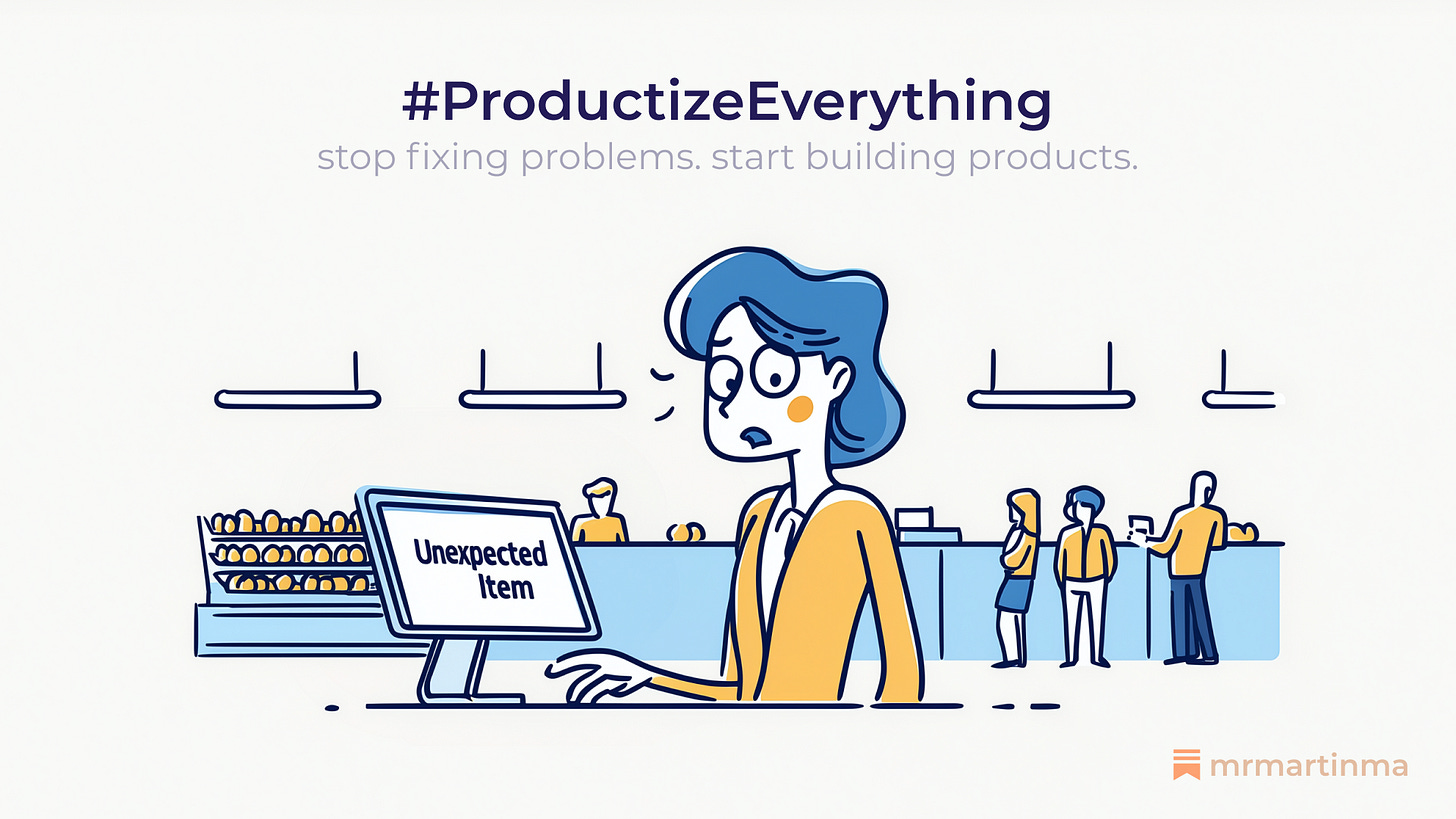It’s a familiar feeling, that special kind of dread. You're standing at the self-checkout line, and the machine designed to make your life easier has just become the single biggest obstacle between you and your dinner.
It’s 5 PM on a Tuesday. You have three items. You just want to go home. You bravely choose the self-checkout lane, hoping for a quick escape.
You scan your first item. Fine. You scan your second, an avocado. The machine screams: "Unexpected item in the bagging area."
An employee comes over, sighs the sigh of a thousand broken workflows, types a secret code, and bypasses the error. They’ve “solved” your problem. But as you walk away, you see them do the exact same thing for the person behind you. And the person behind them.
The employee didn't solve a problem; they applied a patch. The machine is the real problem. The process is the problem.
Now, here’s the scary question: Why do we accept this at work every single day?
Our companies are full of broken self-checkout machines. We have teams - in product, engineering, data, marketing, and sales - who spend all day applying patches to recurring problems and calling it "work."
Your company is full of broken self-checkout machines. The question is, are you building a team of bypass-code specialists, or a team of product builders?
From Temporary Fix to Lasting Solution
What if the store manager, instead of just scheduling more staff to handle overrides, did something radically different? What if they treated "Checkout Lane #4" as a product and the frustrated shopper as their customer?
This simple reframe changes everything. It's no longer about surviving the day; it's about improving the system. This is the "Productize Everything" mindset. It’s the belief that any recurring challenge, internal or external, can be treated as a product to be designed, tested, and improved.
But a mindset needs a map. To do this, the manager uses a simple but powerful tool I call the 5-Box Blueprint. It’s a way to apply the rigor of Design Thinking to any challenge, from a grocery store lane to a go-to-market strategy.
Here’s how it works.
The Foundation: First, Frame the Product & Customer
The manager doesn't just say "the checkout is broken." They get specific. This is the crucial first step that precedes everything else.
Product: The "Express Checkout Experience (1-5 Items)."
Customer: The "Time-Crunched Evening Shopper."
Now, they have a product to build, not just a problem to complain about.
The 5 Boxes: A Blueprint for Action
While every project is different, thinking about how you allocate your time across these boxes is a powerful diagnostic.
1. EMPATHIZE
The manager watches shoppers for 30 minutes. They don't just see errors; they see the why. Shoppers are confused about where to place items, how to look up produce codes, and what the error messages even mean. They feel rushed and a little dumb for not being able to use a "simple" machine.
2. DEFINE
The problem isn't "the machine is buggy." The real problem, framed as a question, is: "How Might We make the checkout process so intuitive that a first-time user feels confident and fast?" This reframes the problem around the customer's feeling, not the machine's function.
3. IDEATE
The manager and a cashier brainstorm. Ideas fly: Bigger on-screen pictures of vegetables? A single, giant "Scan" button? A physical hook to hang reusable bags on so they don't trigger the weight sensor?
4. PROTOTYPE
They don't call corporate to rebuild the software. They tape a simple, laminated sign to the machine that says, "Place bags here FIRST!" with a big arrow. It takes 5 minutes and costs 50 cents. This is a low-fidelity prototype designed for maximum learning, minimum effort.
5. TEST
They watch the next 20 customers. The "unexpected item" error rate drops by 70%. They learned more from a piece of paper in one hour than from a year's worth of complaint data. They have a validated solution.
Now This Isn't Just About Groceries. It's About Growth.
That broken self-checkout is your underperforming marketing campaign. It's the sales process that frustrates your best reps. It's the core product feature that users constantly complain about. For that marketing campaign, your 'Product' might be the 'New User Welcome Series,' and your 'Customer' is the 'Trial User.' The blueprint applies universally.
Every team faces a choice.
They can spend all day applying patches and bypass codes, becoming a reactive service desk. Or they can use the 5-Box Blueprint to become proactive product builders, turning their team from a cost center into a strategic engine for the entire company.
So, here’s my challenge to you.
What is the biggest "broken self-checkout" in your area of the business?
Don't just complain about it in your next meeting. Grab a whiteboard and answer two questions: 1. What is the Product? 2. Who is the Customer? That's the first step. Start there.
I’d love to hear what you come up with.
#ProductManagement #DesignThinking #Leadership #Innovation #ProductizeEverything #ProblemSolving


